-
What is the enrgy provider of Earth?

THE SUN!!!!!
-
Core Temperature of Sun?
~15 million Ko
-
Surface temperature of sun?
~6,000 K (about the same as Earth's core)
-
How does energy from the sun reach Earth?
In electromagnetic energy (light energy) travels to Earth (takes about 8 minutes to reach us)
-
How does the sun produce energy?
Nuclear Fusion constantly occurring in the sun. atoms weight slightly less after these nuclear reactions=this becomes energy released (E (energy) = m (mass) c (speed of light) 2 )
(because it's exponential, even smaller atoms and reactions create a lot of energy)
proton-proton cycle, four hydrogen itoms combined to form helium atoms.
happen in central region of the sun because it is so hot.
this energy travels to the surface to make it out
sun goes through magnetic cycle, affects sunspots/radiation
sun has core, radiative, convective, photosphere, chronosphere, corona
atoms in internal of sun constant internal pressure, nuclear reactions keep it from collapsing into its own gravity
-
What is TSI
Total Solar Irradiance
energy arriving at the top of Earth's atmosphere from Sun
measured in Watts/M2
-
What are sunspots
dark/cool spots on the surface (photosphere) of the sun caused by magnetic fields/distrubances
surrpunded by much brighter areas (facculae/solar flares)
more sunspot activity=brighter
-
do sunspots affect TSI?
yes; more sunspot activity means more irradience
however, this affect is not very drastic, miniscule
-
Sunspot Cycles
go through 11 year cycle of activity
(peaks every 11 years or so)
discovered by Schwabe
these peaks in sunspot activity have been linked with very minor increase in TSI, but not a lot
past few suncpot cycles have demonstrated downward trend
-
Do sunspots affect Earth's climate
kind of:
taking into account earth's temperature, there has been a slight link with variation in temp and sunspot activity, but this activity is about -+.01%, hardly anything drastic.
additionally, sunspot activity in recent cycles have been on downward trend while the earth's temperature has been increasing, indicating that solar activity is not to blame for climate change
-
Orbital Parameters
aspects of the cyles/relationships between Earth and the Sun
-
Orbital eccentricity:
orbit shape changes from circular to more elliptic over time
these cycles take ~100,000 years
(ex: if earth started rotation in a perfect circle, it would take ~100,000 years to return to that perfect shape again)
distance from sun etc varies during orbit
-
Orbital obliquity
tilt of earth on its axis
varies between 22.1o-24.5o
current tilt: 23.44°
cycle: ~40,000 years
-
orbital precession
earth's axis rotates
cycle: ~23,000 years
affects energy received at each pole
-
Ozone (O3) (troposphere)
greenhouse gas
"bad" ozone at lower levels
highly reactive
Comes from:
biomass burning
car exhaust + sun energy
creates smog
big problem in low elevation cities
ex: los angeles
very bad for health
-
ozone O3 (stratosphere)
same chemical as troposphere O3 but in a different place
protects earth from Ultra Violet (UV) radiation
uv light dangerous to cell life
ozone layer shields earth; Earth's "sunscreen"
CFCs break down and react with ozone to make "hole" (thin patch) in ozone layer over antarctica.
-
does the ozone hole cause global warming
no, in fact it actually has more of a potential cooling effect
-
why does the ozone hole cause cooling
the ozone layer usually absorbs the suns ultraviolet and traps infrared heat, heating the earth. but with the ozone hole, more heat is able to escape into space. the big problem is that
1. cfcs causing ozone depletion can fuel greenhouse gases and contribute to warming
2. this cooling effect would be less thatn 1/12th of the warming affect from greenhouse gases
The ozone hole itself has a minor cooling effect (about 2 percent of the warming effect of greenhouses gases) because ozone in the stratosphere absorbs heat radiated to space by gases in a lower layer of Earth’s atmosphere (the upper troposphere). The loss of ozone means slightly more heat can escape into space from that region.
-
Why does the ozone hole form over antarctica
Global warming is also predicted to have a modest impact on the Antarctic ozone hole. The chlorine gases in the lower stratosphere interact with tiny cloud particles that form at extremely cold temperatures — below -80 degrees Celsius (-112 degrees Fahrenheit). While greenhouse gases absorb heat at a relatively low altitudes and warm the surface, they actually cool the stratosphere. Near the South Pole, this cooling of the stratosphere results in an increase in polar stratospheric clouds, increasing the efficiency of chlorine release into reactive forms that can rapidly deplete ozone.
-
What chemicals are in our atmosphere?
nitrogen: 78%
oxygen: 20.9%
argon: ~1%
other stuff: eztremely small amount
(CO2=.0407% or 407 PPM)
-
What is PPM
Parts per million
how we measure gases that make up an incredibly small percentage of our atmosphere
(like greenhouse gases like CO2, 407 ppm)
-
What are the layers of the atmosphere?
thermosphere (very thin)
mesosphere
stratosphere
troposphere (We are here)
-
Chlorofluorocarbons (CFC)
chemicals that react with ozone layer, thin out, cause hole
from: plastic products, refrigerants, arosols
long lasting, hard to get rid of
contribute to greenhouse gas effects on global warming
-
Nitrous Oxide
CAUSES:
NATURAL
bacterial life in soil
microbial activity in oceans
HUMAN
agriculture (fertilization)
medicine (laughing gas)
arosol propellant
combustion engines
(U.S. N2O emissions have been relatively stable but overall global emissions steadily rise)
-
Troposphere
Where:
lowest layer, up to ~10km above ground
Temperature:
temp decreases with higher altitude
most weather occurs here
Contains:
most weather
most water vapor
Etc: we are here
-
stratosphere
Where:
~10-50km above ground, 2nd up
Temperature:
inversion. caps convection (prevents air from rising much further)
higher=hotter
Contains:
ozone layer
some clouds in extreme temperatures above Antarctica, contribute to ozone hole
Etc:
because of temperature stratification (the higher=hotter) the air doesn't mix and leads to less turbulence. lack of vertical convection also means chemicals that get in can stay for a long time (eg CFCs)
-
convection
Convection refers to the overturning and mixing of warmer and colder air layers.
The temperature structure of the stratosphere is one of warmer air over colder air. No, convection never occurs in the stratosphere because of this temperature structure.
-
greenhouse gases
gases which interfere with heat radiation
(put "blanket" around earth)
water vapor
carbon diocide (most abundent greenhouse gas)
methane
nitrous oxide
ozone
haloocarbons
-
carbon dioxide
known as a greenhouse gas since the 1800s
charles keeling
first who thought to mesure it: 1950s
keeling curve
measutinh co2 on a mountain in hawaii, found an upward trend
2022: 420 PPM
annnual wiggles in graph explained by seasonal variety
where coming from?
anthropogenic
fossili fuels, deforestation, etc
~10 gigatons/year
natural
volcanos etc
1/60th of anthropogenic output/year
-
methane
upward trend, inconsistent rate
ANTHROPOGENIC:
energy
landfills
rice agriculture
biomass
cows (when kept in captivity and bred as they are, it's anthropogenic)
NATURAL
wetlands
termites
(50/50 between natural and anthro. maybe anthro 60 and natural 40. about there)
-
Terrestrial Radiation "Budget" Equation
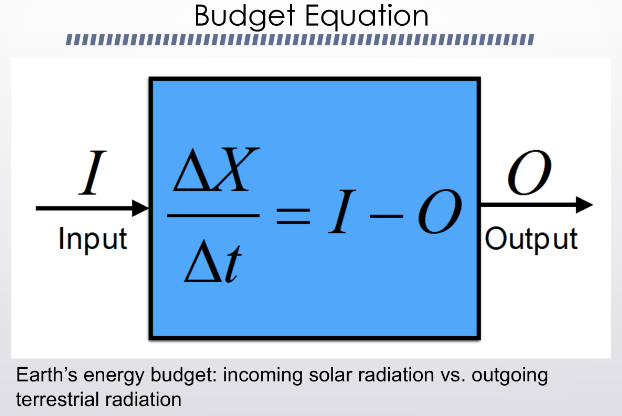
I>O = heating
O>I = cooling
I=O = balance
I-Input
O-output
X-Energy
t-Time
Δ-change
-
Electro Magnetic Radiation:
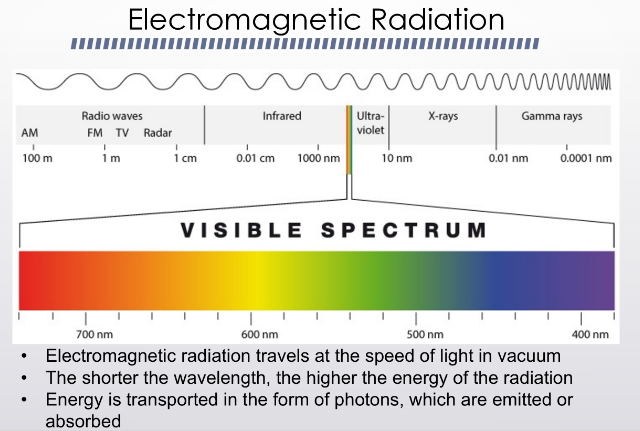
travels at the speed of light (in a vacuum)
shorter wavelenghts=greater energy
energy transported in PHOTONS
what we mostly get from sun: visible spectrum
what earth needs to get rid of to prevent heating: infrared
-
Photons
tiny packets of energy, absorbed by materials
emitted by the sun and travel to earth
-
ultraviolet
"above violet" (after violet/visual spectrum on the electromagnetic spectrum)
absorbed by the ozone layer
-
infrared
"below red" (below red/visual spectrum)
absorbed in water and atmosphere (like CO2)
-
Sun's Emissions
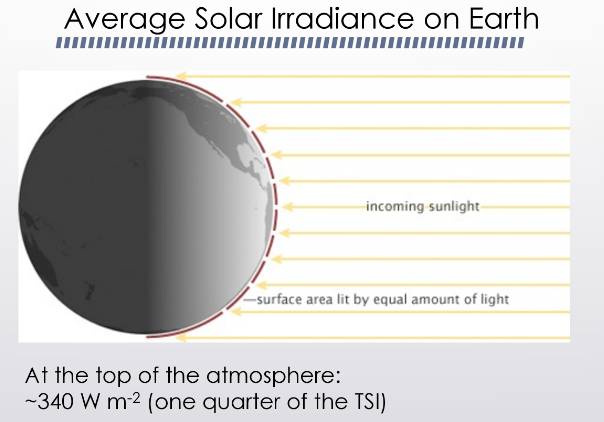
the spectrum emitted by a body depends on the temperature, this is what our sun emits
Mainly VISIBLE-obserbed at TOP of atmosphere and EQUATOR
the radiation is absorbed/disperses at differnt lattitudes and altitudes
infrared most radiation at sea level-
we lost radiation as it goes down because it is absorbed
Equator highest amount of radiation. further away from equator=disperse
~340 w/m2
(this is only 1/4th of TSI but that's because it's averaged across a planet that rotates, not all of it gets equal sun at once)
-
what part of earth recieves the most/the most visual spectrum radiation?
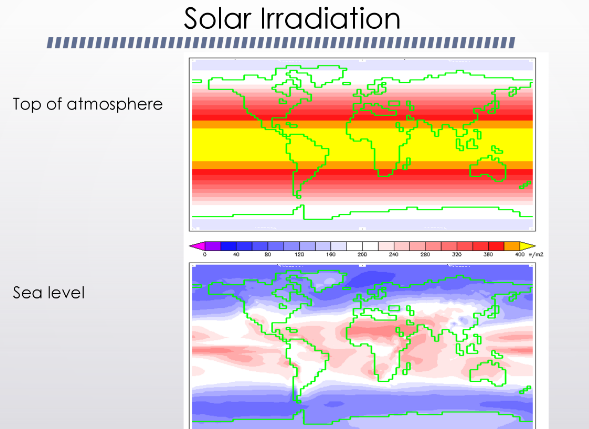
the top of the atmosphere at the equator
-
what type of radiation is found at the bottom of the ocean?
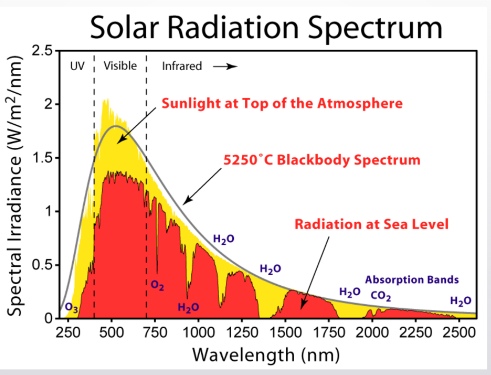
mostly infrared, less radiation than top of atmosphere


